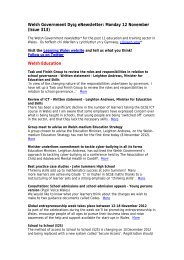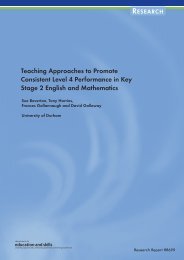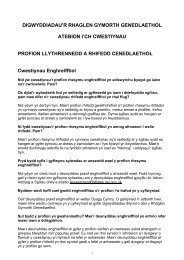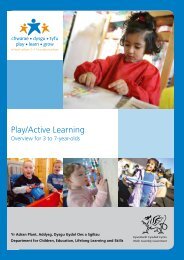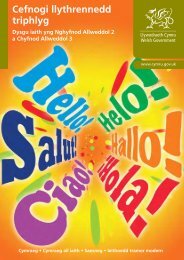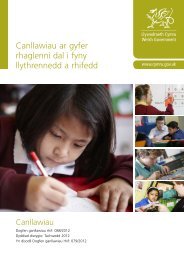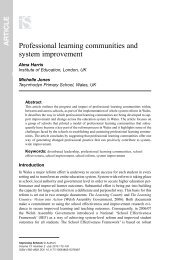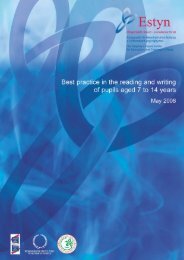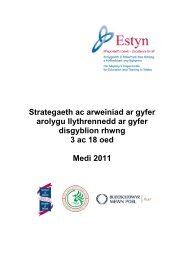Improving the learning and teaching of early reading skills - Estyn
Improving the learning and teaching of early reading skills - Estyn
Improving the learning and teaching of early reading skills - Estyn
You also want an ePaper? Increase the reach of your titles
YUMPU automatically turns print PDFs into web optimized ePapers that Google loves.
plays an important part in <strong>the</strong> development <strong>of</strong> decoding strategies needed in later<br />
<strong>reading</strong>. According to Carroll et al. (2003) <strong>and</strong> Duncan et al. (2000), children tend<br />
to develop syllable <strong>and</strong> rime awareness before phoneme awareness; development<br />
progresses from global to segmental phonological awareness. Moreover,<br />
phonological processing ability explains significant differences between good <strong>and</strong><br />
poor readers. Deficits, it is argued, can be remedied through instructional<br />
programmes <strong>and</strong> this ultimately affects positively on <strong>reading</strong> <strong>and</strong> spelling acquisition.<br />
There is disagreement about possible causal links between rhyme awareness <strong>and</strong><br />
orthographic rime analogy, on <strong>the</strong> one h<strong>and</strong>, <strong>and</strong> <strong>the</strong> development <strong>of</strong> <strong>early</strong> <strong>reading</strong><br />
<strong>skills</strong>, on <strong>the</strong> o<strong>the</strong>r. Goswami (1999; 2001) makes <strong>the</strong> case for a causal relationship.<br />
Savage (2001), in contrast, argues that <strong>the</strong> nature <strong>of</strong> <strong>the</strong> relationship between<br />
phonological rhyme awareness <strong>and</strong> <strong>reading</strong> remains controversial <strong>and</strong> that significant<br />
doubt remains regarding <strong>the</strong> nature <strong>and</strong> relevance <strong>of</strong> analogy in <strong>early</strong> <strong>reading</strong>.<br />
Castles <strong>and</strong> Col<strong>the</strong>art (2004) also maintain that <strong>the</strong> causal link between phonological<br />
awareness <strong>and</strong> <strong>reading</strong> <strong>and</strong> spelling ability has not yet been proven empirically. In<br />
<strong>the</strong>ir view, phonological awareness must be thought <strong>of</strong> as one <strong>of</strong> <strong>the</strong> many<br />
interesting, but not necessarily causally connected, cognitive correlates <strong>of</strong> <strong>reading</strong><br />
<strong>and</strong> spelling achievement.<br />
Phonemic Awareness<br />
As is <strong>the</strong> case with phonological awareness, whilst it is widely accepted that<br />
phonemic awareness plays an important role in literacy development, <strong>the</strong>re is little<br />
common underst<strong>and</strong>ing <strong>of</strong> how it is implicated in <strong>the</strong> <strong>learning</strong> to read process <strong>and</strong><br />
how it should be taught (Yopp <strong>and</strong> Yopp, 2000).<br />
There are several views on <strong>the</strong> relationship between phonemic awareness <strong>and</strong><br />
<strong>reading</strong> development. The first is that phonemic awareness precedes or improves<br />
<strong>reading</strong> (Goswami <strong>and</strong> Bryant, 1990; Stahl <strong>and</strong> Murray, 1994; Wagner et al., 1994)<br />
<strong>and</strong> predicts later success in <strong>reading</strong> <strong>and</strong> spelling (Lundberg et al., 1980). These<br />
views were supported in our review. Lerkkanen (2004) tracked phonemic awareness<br />
<strong>and</strong> <strong>reading</strong> performance in 85 Finnish children following a phonics-based <strong>reading</strong><br />
programme in six different schools during <strong>the</strong>ir first year. Reading performance at<br />
<strong>the</strong> beginning <strong>of</strong> <strong>the</strong> year was found to predict subsequent levels <strong>of</strong> phonemic<br />
awareness, which, in turn, predicted levels <strong>of</strong> <strong>reading</strong> towards <strong>the</strong> end <strong>of</strong> <strong>the</strong> year.<br />
Ehri et al’s (2001) submission to <strong>the</strong> US National Reading Panel also reported that<br />
phonemic awareness had a moderate statistically significant impact on <strong>reading</strong> <strong>and</strong><br />
spelling. Word <strong>reading</strong> <strong>and</strong> <strong>reading</strong> comprehension, in particular, benefited.<br />
Discussing <strong>the</strong> limitations <strong>of</strong> <strong>the</strong>ir study, Ehri et al. conclude that phonemic<br />
awareness should not be taught in isolation but ra<strong>the</strong>r in conjunction with<br />
grapheme-phoneme knowledge, <strong>and</strong> this knowledge should be applied to <strong>reading</strong><br />
<strong>and</strong> writing. Castles <strong>and</strong> Col<strong>the</strong>art (2004: 104) who argue that ‘it may not be possible<br />
for phonemic awareness to be acquired in <strong>the</strong> absence <strong>of</strong> instruction on <strong>the</strong> links<br />
between phonemes <strong>and</strong> graphemes’ support <strong>the</strong>se views.<br />
The second hypo<strong>the</strong>sis is that phonemic awareness develops as knowledge <strong>of</strong> <strong>the</strong><br />
alphabetic system <strong>and</strong> spellings evolve (Ehri, 1989; Stahl <strong>and</strong> Murray, 1994). In this<br />
regard, Ehri et al. (2001) report contradictory findings: some <strong>of</strong> <strong>the</strong> studies <strong>the</strong>y<br />
reviewed provided support for <strong>the</strong> impact <strong>of</strong> phonemic awareness on <strong>reading</strong> <strong>and</strong>



